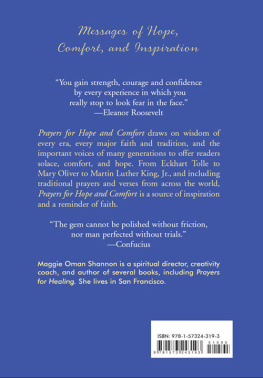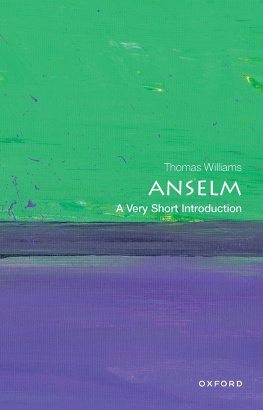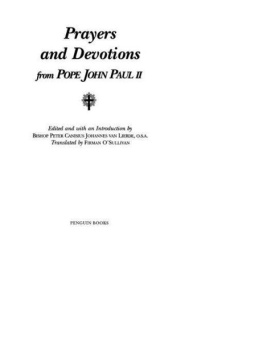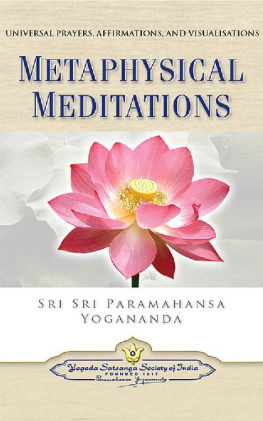Anselm of Aosta - The Prayers and Meditations of St. Anselm with the Proslogion
Here you can read online Anselm of Aosta - The Prayers and Meditations of St. Anselm with the Proslogion full text of the book (entire story) in english for free. Download pdf and epub, get meaning, cover and reviews about this ebook. City: London, year: 2006;2010, publisher: Penguin Group USA, Inc., genre: Religion. Description of the work, (preface) as well as reviews are available. Best literature library LitArk.com created for fans of good reading and offers a wide selection of genres:
Romance novel
Science fiction
Adventure
Detective
Science
History
Home and family
Prose
Art
Politics
Computer
Non-fiction
Religion
Business
Children
Humor
Choose a favorite category and find really read worthwhile books. Enjoy immersion in the world of imagination, feel the emotions of the characters or learn something new for yourself, make an fascinating discovery.
- Book:The Prayers and Meditations of St. Anselm with the Proslogion
- Author:
- Publisher:Penguin Group USA, Inc.
- Genre:
- Year:2006;2010
- City:London
- Rating:4 / 5
- Favourites:Add to favourites
- Your mark:
- 80
- 1
- 2
- 3
- 4
- 5
The Prayers and Meditations of St. Anselm with the Proslogion: summary, description and annotation
We offer to read an annotation, description, summary or preface (depends on what the author of the book "The Prayers and Meditations of St. Anselm with the Proslogion" wrote himself). If you haven't found the necessary information about the book — write in the comments, we will try to find it.
Combining personal ardor and scrupulous theology, Prayers and Meditations offers an intimate view of this Archbishop of Canterbury, most noted for his acceptance of rational inquiry into the mysteries of faith.
The Prayers and Meditations of St. Anselm with the Proslogion — read online for free the complete book (whole text) full work
Below is the text of the book, divided by pages. System saving the place of the last page read, allows you to conveniently read the book "The Prayers and Meditations of St. Anselm with the Proslogion" online for free, without having to search again every time where you left off. Put a bookmark, and you can go to the page where you finished reading at any time.
Font size:
Interval:
Bookmark:

THE PRAYERS AND MEDITATIONS OF ST ANSELM WITH THE PROSLOGION
ADVISORY EDITOR: BETTY RADICE
A NSELM , bishop and theologian, was born at Aosta c. 1033, the son of a Lombard nobleman. After a restless youth, he entered in 1059 the monastery of Bec in Normandy, whose prior was then Lanfranc, who was to precede him in the see of Canterbury. During the next thirty years Anselm wrote several of the philosophical and theological works that have been so influential and which earned him the title of the father of scholasticism. He was elected abbot of Bec in 1078, and in 1093 King William II consented to nominate him to the archbishopric of Canterbury. Henceforth, Anselms public life was almost wholly conditioned by dissensions with William II and Henry I over relations between the church and the state as represented by the king. In 1097, due to William IIs determined efforts to get rid of the archbishop, Anselm went to Rome for three years; during that time he wrote Cur Deus Homo, one of the best known works on the Atonement, and attended the Council of Bari. He returned to England when Henry I came to the throne, but Henry soon claimed rights in respect of abbots and bishops that a council in Rome had been unable to recognize; Anselm was again in exile abroad from 1103 to 1107. He died in 1109 in Canterbury.
Benedicta Ward is a member of the Anglican religious community of the Sisters of the Love of God. She holds a degree in history and a D.Phil. from Oxford. Her doctoral thesis has been published as Miracles and the Medieval Mind (1982, reprinted 1987) and she is the author of several books on early monasticism, including most recently a monograph on The Venerable Bede, published in 1991. Sister Benedicta is a member of the Theology Faculty at Oxford and is also a lecturer at Manchester College.

Translated and with an introduction by SisterBenedictaWard, S.L.G.
With a foreword byR. W . Southern
PENGUIN BOOKS
PENGUIN BOOKS
Published by the Penguin Group
Penguin Books Ltd, 27 Wrights Lane, London W8 5TZ, England
Penguin Putnam Inc., 375 Hudson Street, New York, New York 10014, USA
Penguin Books Australia Ltd, Ringwood, Victoria, Australia
Penguin Books Canada Ltd, 10 Alcorn Avenue, Toronto, Ontario, Canada M4V 3B2
Penguin Books (NZ) Ltd, Private Bag 102902, NSMC, Auckland, New Zealand
Penguin Books Ltd, Registered Offices: Harmondsworth, Middlesex, England
This translation first published 1973
Copyright Benedicta Ward, 1973
Foreword Copyright R. W. Southern, 1973
All rights reserved
Except in the United States of America, this book is sold subject to the condition that it shall not, by way of trade or otherwise, be lent, re-sold, hired out, or otherwise circulated without the publishers prior consent in any form of binding or cover other than that in which it is published and without a similar condition including this condition being imposed on the subsequent purchaser
ISBN: 9781101492123
In his Prayers and Meditations Anselm created a new kind of poetry the poetry of intimate, personal devotion. These poems were not written in lines and stanzas, but in the rhymed prose which was a fashionable literary mode in the late eleventh century, and with the intricate antitheses which were a special feature of Anselms thought and art. The carefully constructed form and choice of words convey the heightened emotion of poetry, and it is one of the great merits of this translation that both the emotion and poetic form have been carefully preserved.
The form and the emotion cannot be separated. What Anselm attempted was, first of all, to stir up his own sense of horror, compunction, humiliation, and self-abasement at the recollection of his sins, and then to communicate these feelings to the reader, by arranging his words to give them their fullest possible effect. They were (he said) to be read not cursorily or quickly, but slowly and with profound and deliberate meditation; and we find in fact that it is impossible to read them in any other way. Eye and mind alike are arrested by the intricacies of construction and thought, and Anselms literary art serves to enforce the principles of meditation on which he insisted.
The practice of meditative prayer was already very ancient when Anselm began to write his prayers, but he introduced some important innovations both as regards the public for which he wrote and in his manner of writing. Until his time meditation had been essentially a monastic exercise, and Anselm certainly wrote largely for monks; but he also wrote to meet the increasingly articulate needs of lay people, especially of women in great positions who had the time, inclination, and wealth to adopt the religious practices of the monastic life. Such women were among the earliest recipients of his prayers, and one of them, Countess Mathilda of Tuscany, was one of the main agents of their dissemination.
In his manner of writing also Anselm made a distinct break with the past. When he started to write, extracts from the Psalms formed the main texts for private devotion. In addition, there were already in existence several collections of short prayers for private use, but they had not yet established themselves as a distinct form of religious literature. Anselms prayers made the distinction at once complete and irreversible. They were longer, more subtle, more personal, and theologically more daring, than any earlier prayers in use in the West; and they were clearly unsuitable for public use.
Most of Anselms prayers are addressed to individual saints. In casting them in this form he was following an established devotional practice, but here too he did something which was new. He threw himself before the saint with so personal an appeal and so vivid an evocation of the saints personality, that his prayers have a visual quality like a picture by El Greco. The saint stands out as a central dominating figure in a brilliant and varied canvas.
The Prayer to St Peter is a good example of Anselms method. He addresses St Peter in every possible guise: as a worn-out sinner addressing the chief of the apostles, as a scabby sheep addressing the shepherd of the flock, as a wounded desperate soul addressing the door-keeper of heaven. Then, by a subtle change of view, the readers attention is directed to the fact that St Peter himself had needed and received mercy and forgiveness. Thereafter the prayer turns into a petition to God and St Peter, sometimes jointly, sometimes singly, and ends in a final intricate pattern of imploration. It is altogether much too elaborate and artificial for our taste, but it leaves an intense sense of the contrast between the squalid sinful soul and the glory to which the soul aspires.
The main art of Anselm in his prayers is directed towards bringing out this contrast. He piles up images and epithets to emphasize the misery, squalor, and desperation of the sinful soul, overwhelmed in the mire and stench of its own making, just managing to articulate entreaties to the shining friends and collaborators of God. The misery of the individual soul would seem simply vast and shapeless were it not given a certain degree of form by the precise rhythms of Anselms prose, the refinement of his language, and the extraordinary boldness of his imagery. It is by these devices that Anselm arouses the sinners interest in his condition, and keeps this interest alive even while he is being bludgeoned into numbness by the long enumeration of his evils. For instance, in his very long Prayer to St Paul, Anselm explores every aspect of Pauls career to find an avenue of approach along which the sinner can travel with confidence. But all in vain. Everywhere he comes up against an impenetrable wall of sin. Then he stumbles on some words of St Paul in his Epistles to the Thessalonians and Galatians which suggest the contrasting images of a nurse and a woman in labour. With this flimsy aid Anselm finds a new approach to St Paul, now depicted as a tender nurse and mother. There is indeed a faint absurdity in this double image, but it serves to provide a climax for the prayer by suggesting a further image of Jesus dying in spiritual childbirth so that his children in the faith may live. The two images are then combined, and tossed to and fro both Paul and Jesus are mothers, both are fathers too until the prayer ends in a general sense of consolation.
Next pageFont size:
Interval:
Bookmark:
Similar books «The Prayers and Meditations of St. Anselm with the Proslogion»
Look at similar books to The Prayers and Meditations of St. Anselm with the Proslogion. We have selected literature similar in name and meaning in the hope of providing readers with more options to find new, interesting, not yet read works.
Discussion, reviews of the book The Prayers and Meditations of St. Anselm with the Proslogion and just readers' own opinions. Leave your comments, write what you think about the work, its meaning or the main characters. Specify what exactly you liked and what you didn't like, and why you think so.











